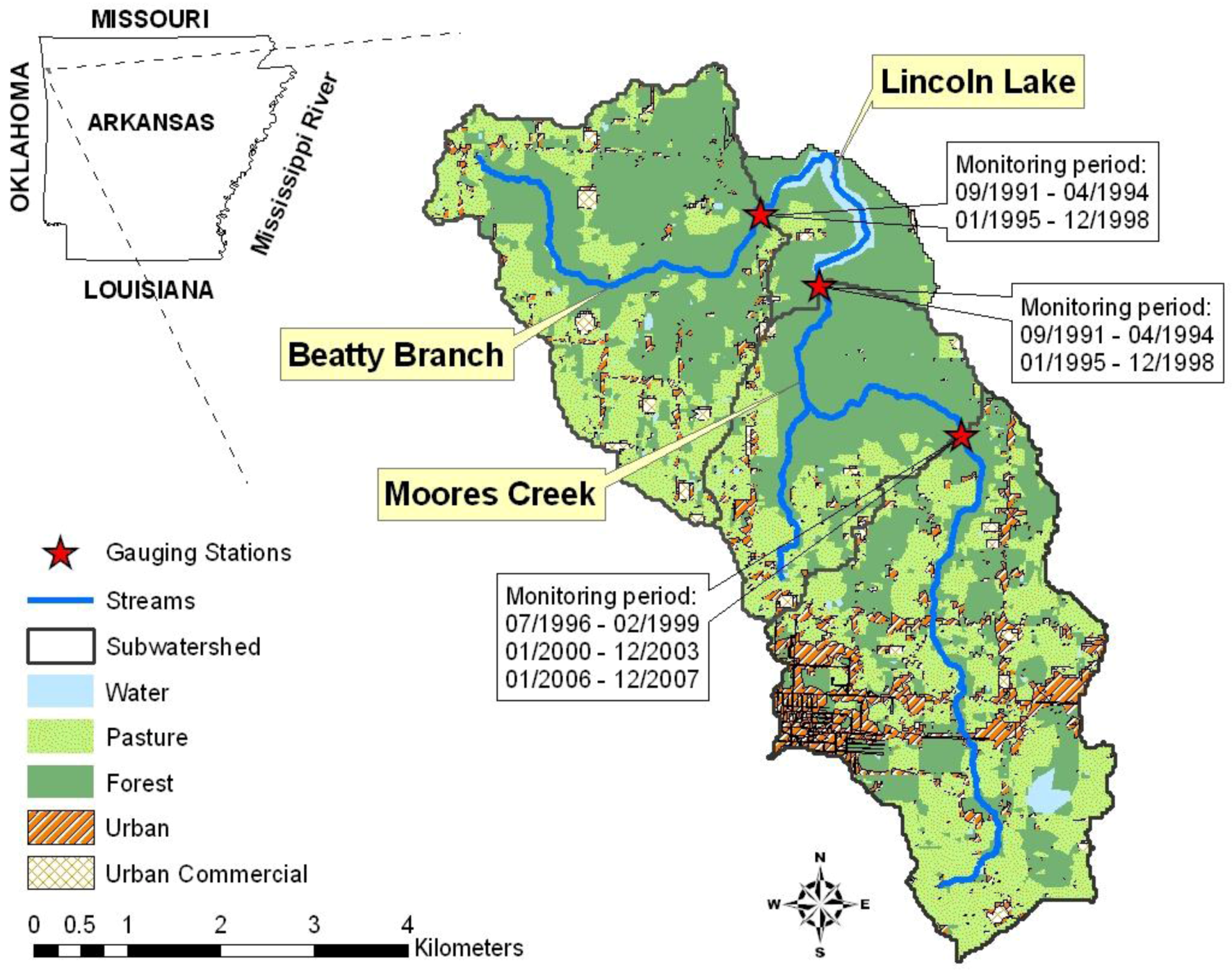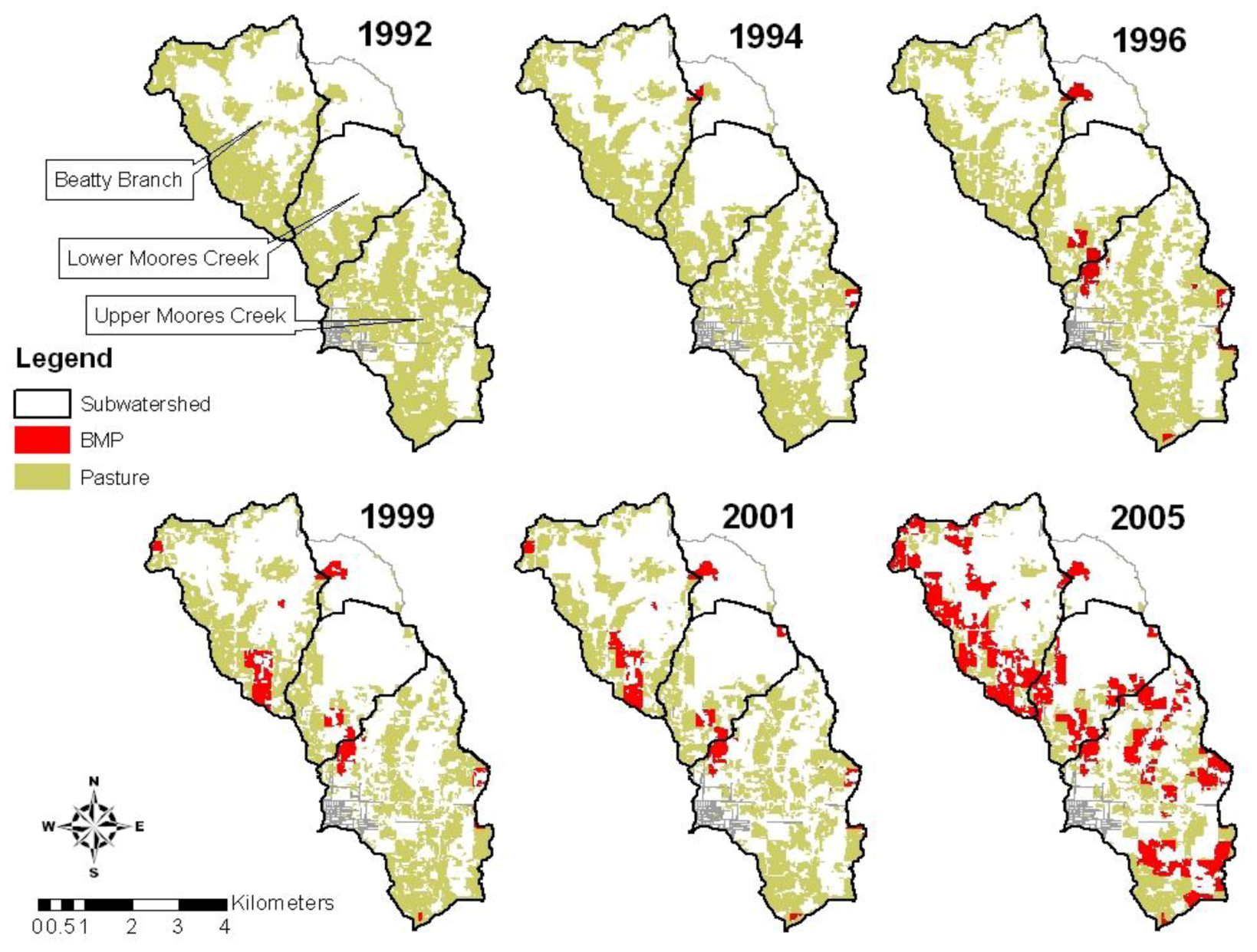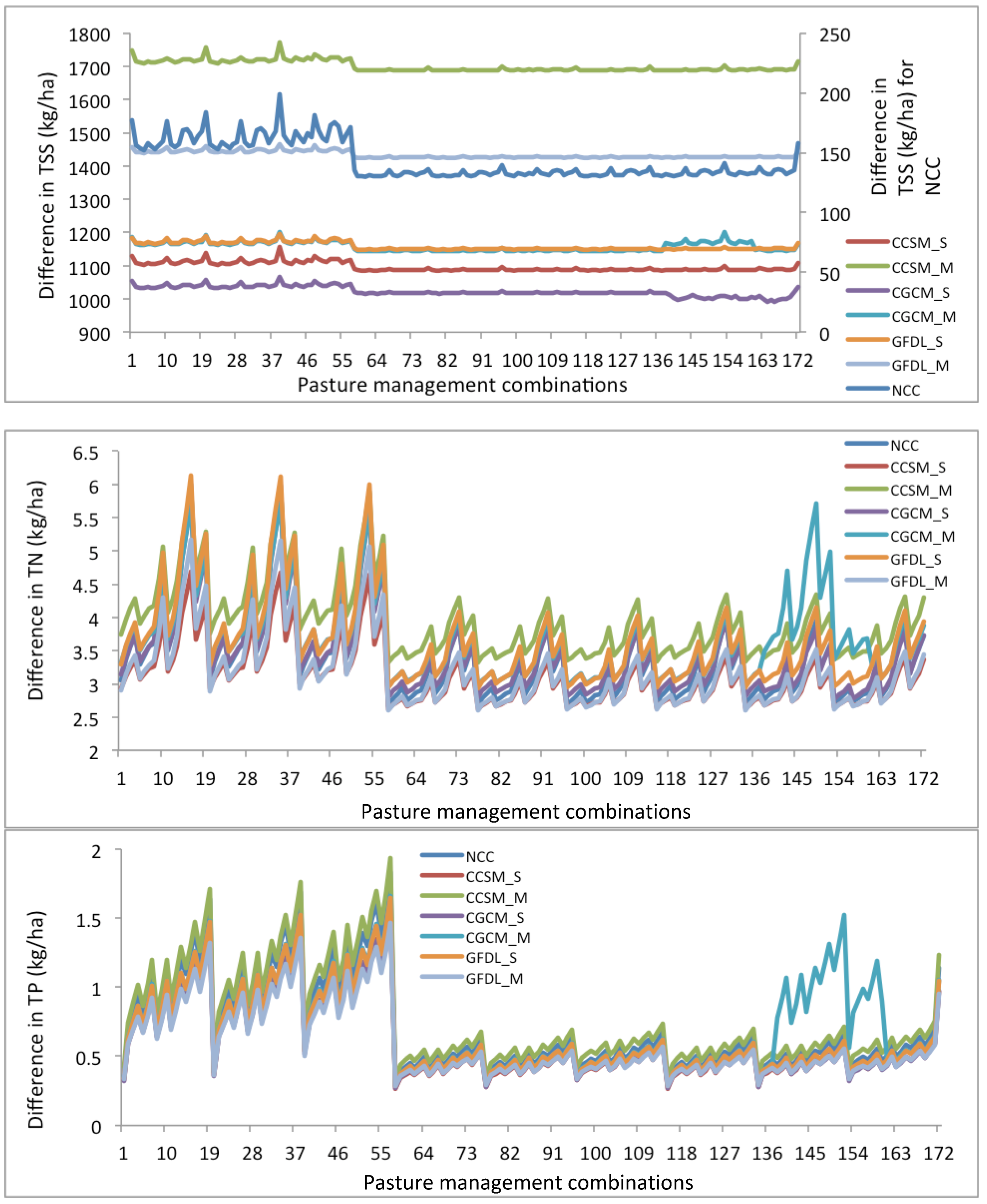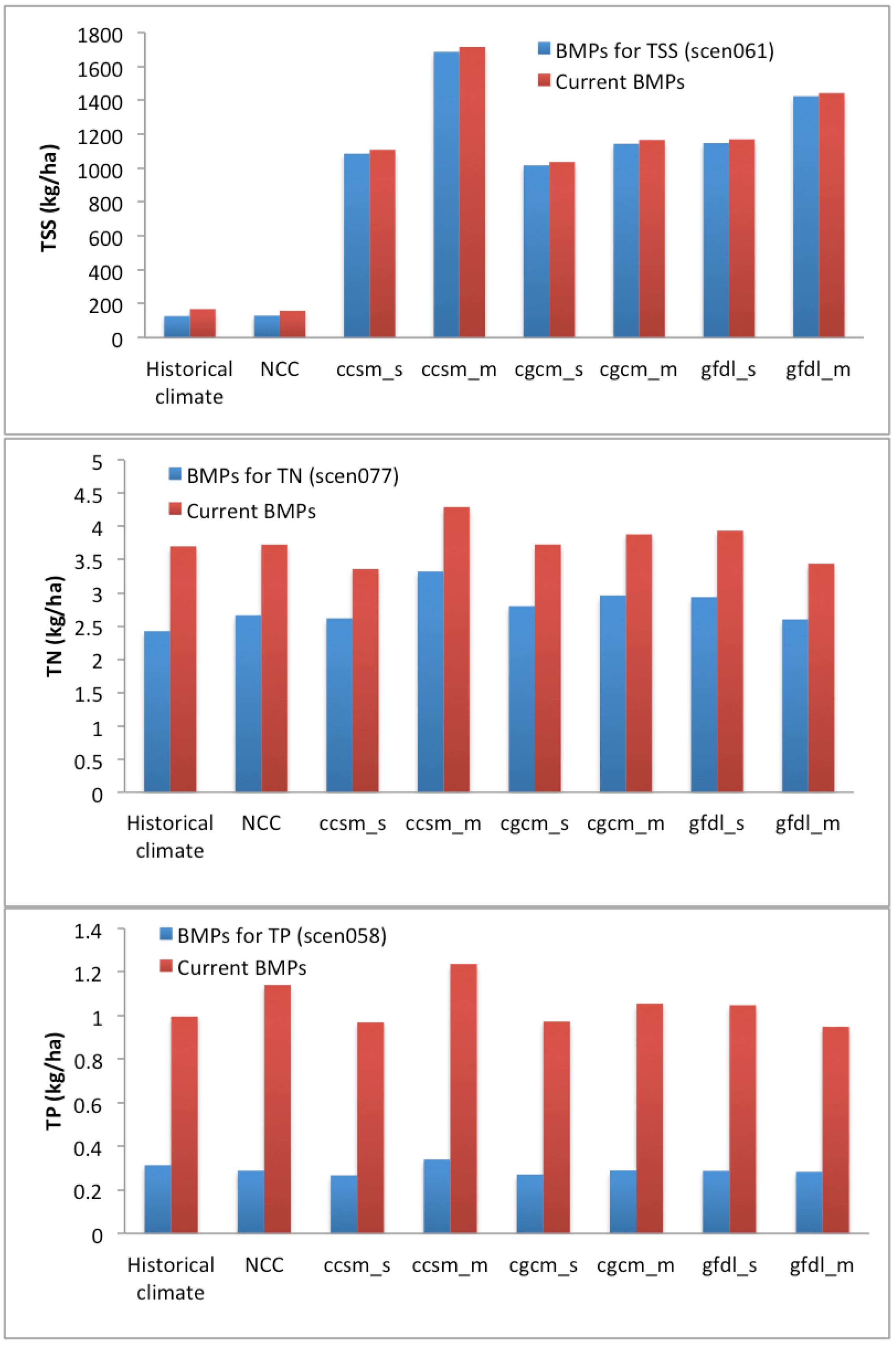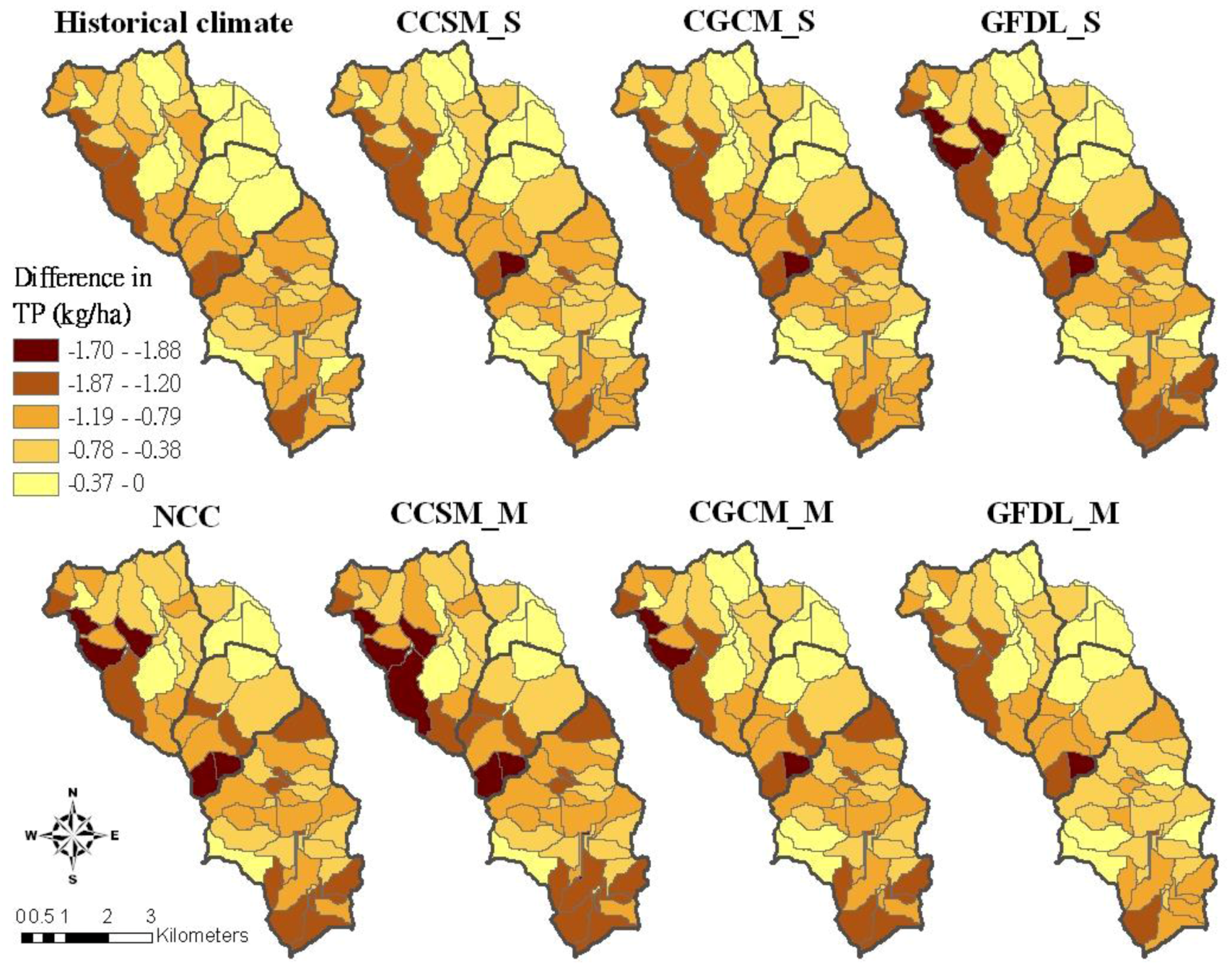3.2.1. Under Historical Climate Condition (1992–2007)
Many studies have evaluated the hydrological impacts of land use changes by hypothetically predicting the land use changes, such as conversion of the entire watershed to agricultural lands, or systematically changing land use distribution at different percentages [
12,
14]. Such simulation results may fail to provide an expectation on how a watershed would respond when a complex land use change occurs. This study incorporated the historical land use changes with corresponding agricultural management, and measured weather data into the model simulation to reduce the uncertainty in the evaluation of current conservation practices. Additionally, evaluating the performance of alternative conservation practices that would have further improved water quality provides more precise information on their effectiveness for making future watershed management decisions.
Table 5,
Table 6, and
Table 7 summarize the effectiveness of 171 different management practice combinations in reducing annual pollutant losses from the watershed for total suspended sediment (TSS), total N (TN), and total P (TP), respectively. Notably, the values shown in these tables are the average annual values during the simulation period (1992–2007) and can be considered as the average watershed responses for these management practice scenarios. These simulation results for 171 scenarios were compared with the pollutant losses from the current management practice (baseline) scenario, which included various pasture management practices in the watershed from 1992 to 2007 [
5].
The best management practice combination for mitigating TSS losses is scenario 61, which is a combination of 4.94 t/ha alum-amended litter applied in spring, no grazing and a VFS ratio of 42. The worst management practice combination is scenario 39, which is a combination of no litter application, overgrazing and no VFS. Vegetated filter strips (VFS) were the most influential management practices for reducing sediment losses. In the same field, a smaller VFS ratio indicates a larger VFS compared to a larger VFS ratio, indicating that a smaller VFS is implemented. In this study, the VFS ratios were derived using the maximum sediment loads (2,333 kg/ha/year) from the Lincoln Lake watershed under various weather conditions during a 25-year period (2004–2028). However, the maximum sediment loads (224.3 kg/ha/year for scenario 39) from the watershed over the past 16 years (1992–2007) were significantly less than the sediment loads in extreme weather conditions. Therefore, a VFS ratio of 76 could reduce sediment losses by 14.1%–23.8% compared with the baseline scenario. A VFS ratio of 42 resulted in similar sediment losses ranging from 127.1 to 141.1 kg/ha/year (
Table 5) with corresponding reductions of 24.2% and 15.8%, respectively. When no VFS was implemented, overgrazing increased sediment losses from 164.7 to 224.3 kg/ha/year as the results of a loss of vegetative cover, soil compaction and reduction in infiltration. When no VFS was implemented, TSS losses generally increased with the intensity of grazing for all nutrient management scenarios. Litter application timing also affected the losses of sediment. For example, TSS losses of 197.5, 179.7, and 159.3 kg/ha/year were simulated when 4.94 t/ha alum-treated litter was applied in summer, fall and spring seasons, respectively. Spring and fall are the primary growing seasons for Bermuda grass and Fescue grass, while Bermuda was harvested twice in mid July and September. Therefore, summer application affected growth of grass to a lesser extent, and TSS losses were greater than those for spring and fall applications. Additionally, plants may experience nutrient stress when no litter is applied, resulting in less vegetated cover and increased losses of TSS.
Table 5.
Total suspended sediment (TSS, kg/ha) losses from the Lincoln Lake watershed under 171 management practice scenarios (NG: no grazing, OG: optimum grazing, OVG: over grazing), VFS (vegetative filter strips, no VFS, VFS ratio = 42, 76) and application timing (spring, summer and fall applications), where the number indicates the litter amount in ton/acre unit with non-alum (NA) or alum (A) amended poultry litter. Bold value and underlined value indicate the best and the worst pasture management scenarios, respectively.
Table 5.
Total suspended sediment (TSS, kg/ha) losses from the Lincoln Lake watershed under 171 management practice scenarios (NG: no grazing, OG: optimum grazing, OVG: over grazing), VFS (vegetative filter strips, no VFS, VFS ratio = 42, 76) and application timing (spring, summer and fall applications), where the number indicates the litter amount in ton/acre unit with non-alum (NA) or alum (A) amended poultry litter. Bold value and underlined value indicate the best and the worst pasture management scenarios, respectively.
| | VFS ratio |
|---|
| | 0 | | 42 | | 76 |
|---|
| | Grazing and Pasture Management |
|---|
| Manure application (t/ha)-type | NG | OG | OVG | | NG | OG | OVG | | NG | OG | OVG |
|---|
| No application | | 187.1 | 195.3 | 224.3 | | 133.0 | 134.8 | 141.1 | | 134.2 | 136.3 | 144.0 |
| Spring | | | | | | | | | | | | |
| 2.47A | | 166.1 | 167.8 | 177.0 | | 128.4 | 128.7 | 130.4 | | 129.1 | 129.4 | 131.3 |
| 3.71A | | 162.1 | 163.2 | 169.5 | | 127.6 | 127.8 | 128.9 | | 128.2 | 128.4 | 129.7 |
| 4.94A | | 159.3 | 160.0 | 164.7 | | 127.1 | 127.2 | 128.0 | | 127.6 | 127.8 | 128.6 |
| 2.47NA | | 168.2 | 170.5 | 182.3 | | 128.9 | 129.3 | 131.4 | | 129.6 | 130.1 | 132.4 |
| 3.71NA | | 164.4 | 165.9 | 174.7 | | 128.1 | 128.3 | 129.9 | | 128.7 | 129.0 | 130.7 |
| 4.94NA | | 161.4 | 162.5 | 169.1 | | 127.5 | 127.7 | 128.8 | | 128.1 | 128.3 | 129.5 |
| Summer | | | | | | | | | | | | |
| 2.47A | | 165.3 | 167.9 | 186.4 | | 128.5 | 129.0 | 132.6 | | 129.2 | 129.7 | 133.8 |
| 3.71A | | 172.2 | 172.9 | 183.8 | | 129.9 | 129.9 | 131.7 | | 130.8 | 130.8 | 132.8 |
| 4.94A | | 197.5 | 198.3 | 210.8 | | 135.1 | 135.1 | 137.3 | | 137.1 | 137.0 | 139.4 |
| 2.47NA | | 166.4 | 169.2 | 190.1 | | 128.7 | 129.3 | 133.4 | | 129.4 | 130.0 | 134.8 |
| 3.71NA | | 164.1 | 166.3 | 181.0 | | 128.2 | 128.6 | 131.3 | | 128.9 | 129.3 | 132.4 |
| 4.94NA | | 170.0 | 170.5 | 180.0 | | 129.4 | 129.4 | 131.0 | | 130.2 | 130.2 | 132.0 |
| Fall | | | | | | | | | | | | |
| 4.94A | | 179.7 | 180.9 | 187.3 | | 131.5 | 131.7 | 132.7 | | 132.8 | 133.0 | 134.0 |
| 6.18A | | 184.2 | 185.7 | 193.8 | | 132.4 | 132.7 | 134.1 | | 133.9 | 134.2 | 135.7 |
| 7.41A | | 180.0 | 181.4 | 189.6 | | 131.5 | 131.7 | 133.2 | | 132.7 | 133.0 | 134.7 |
| 4.94NA | | 167.4 | 168.1 | 172.6 | | 129.1 | 129.2 | 129.8 | | 129.9 | 130.0 | 130.6 |
| 6.18NA | | 175.3 | 176.1 | 180.1 | | 130.7 | 130.8 | 131.4 | | 131.8 | 131.9 | 132.5 |
| 7.41NA | | 181.8 | 182.7 | 187.4 | | 132.0 | 132.2 | 132.9 | | 133.4 | 133.5 | 134.3 |
The best management practice combination (
i.e., scenario 77) for cumulative TN losses comprises no litter application, optimum grazing and a VFS ratio of 42, while the worst management practice combination (
i.e., scenario 16) consists of 7.41 t/ha alum-treated litter application in the fall, no grazing and no VFS. Overgrazing decreased losses of TN from the watershed for all litter application rates, application timings, and VFS ratios (
Table 6). Nutrients are normally removed from pastures by haying or by animals through grazing. When a pasture is grazed, nutrients can be returned to pasture lands via animal urine and feces excreted. Since nitrogen is usually the limiting nutrient for pasture growth, nitrogen inputs as fertilizer or manure are needed to sustain forage production. Therefore, overgrazing reduced TN losses, possibly because the amount of N removed via forage consumed by grazing animals is greater than that of N returned to the pasture in the form of animal manure. However, overgrazing increased TN losses when no litter was applied.
Table 6.
Total nitrogen (TN, kg/ha) losses from the Lincoln Lake watershed under 171 management practice scenarios (NG: no grazing, OG: optimum grazing, OVG: over grazing), VFS (vegetative filter strips, no VFS, VFS ratio = 42, 76) and application timing (spring, summer and fall applications), where the number indicates the litter amount in ton/acre unit with non-alum (NA) or alum (A) amended poultry litter. Bold value and underlined value indicate the best and the worst pasture management scenarios, respectively.
Table 6.
Total nitrogen (TN, kg/ha) losses from the Lincoln Lake watershed under 171 management practice scenarios (NG: no grazing, OG: optimum grazing, OVG: over grazing), VFS (vegetative filter strips, no VFS, VFS ratio = 42, 76) and application timing (spring, summer and fall applications), where the number indicates the litter amount in ton/acre unit with non-alum (NA) or alum (A) amended poultry litter. Bold value and underlined value indicate the best and the worst pasture management scenarios, respectively.
| | VFS ratio |
|---|
| | 0 | | 42 | | 76 |
|---|
| | Grazing and Pasture Management |
|---|
| Manure application (t/ha)-type | NG | OG | OVG | | NG | OG | OVG | | NG | OG | OVG |
|---|
| No application | | 3.0 | 3.0 | 3.1 | | 2.4 | 2.4 | 2.5 | | 2.4 | 2.4 | 2.5 |
| Spring | | | | | | | | | | | | |
| 2.47A | | 3.3 | 3.3 | 3.2 | | 2.5 | 2.5 | 2.5 | | 2.6 | 2.6 | 2.5 |
| 3.71A | | 3.5 | 3.5 | 3.3 | | 2.6 | 2.6 | 2.6 | | 2.7 | 2.6 | 2.6 |
| 4.94A | | 3.7 | 3.6 | 3.5 | | 2.7 | 2.7 | 2.6 | | 2.7 | 2.7 | 2.7 |
| 2.47NA | | 3.2 | 3.2 | 3.1 | | 2.5 | 2.5 | 2.5 | | 2.6 | 2.5 | 2.5 |
| 3.71NA | | 3.4 | 3.4 | 3.2 | | 2.6 | 2.6 | 2.5 | | 2.6 | 2.6 | 2.5 |
| 4.94NA | | 3.5 | 3.5 | 3.4 | | 2.6 | 2.6 | 2.6 | | 2.7 | 2.7 | 2.6 |
| Summer | | | | | | | | | | | | |
| 2.47A | | 3.6 | 3.6 | 3.5 | | 2.7 | 2.7 | 2.6 | | 2.7 | 2.7 | 2.7 |
| 3.71A | | 4.3 | 4.2 | 4.0 | | 2.9 | 2.9 | 2.8 | | 3.0 | 2.9 | 2.9 |
| 4.94A | | 5.1 | 5.0 | 4.9 | | 3.2 | 3.2 | 3.1 | | 3.3 | 3.3 | 3.2 |
| 2.47NA | | 3.5 | 3.5 | 3.4 | | 2.6 | 2.6 | 2.6 | | 2.7 | 2.7 | 2.6 |
| 3.71NA | | 3.8 | 3.8 | 3.7 | | 2.8 | 2.7 | 2.7 | | 2.8 | 2.8 | 2.7 |
| 4.94NA | | 4.2 | 4.2 | 4.0 | | 2.9 | 2.9 | 2.8 | | 3.0 | 2.9 | 2.9 |
| Fall | | | | | | | | | | | | |
| 4.94A | | 5.3 | 5.3 | 5.1 | | 3.3 | 3.3 | 3.2 | | 3.4 | 3.4 | 3.3 |
| 6.18A | | 6.0 | 5.9 | 5.8 | | 3.6 | 3.6 | 3.5 | | 3.7 | 3.7 | 3.6 |
| 7.41A | | 6.5 | 6.5 | 6.3 | | 3.8 | 3.8 | 3.7 | | 3.9 | 3.9 | 3.8 |
| 4.94NA | | 4.5 | 4.4 | 4.3 | | 3.0 | 3.0 | 2.9 | | 3.1 | 3.1 | 3.0 |
| 6.18NA | | 4.9 | 4.9 | 4.7 | | 3.2 | 3.2 | 3.1 | | 3.3 | 3.3 | 3.2 |
| 7.41NA | | 5.4 | 5.4 | 5.2 | | 3.4 | 3.4 | 3.3 | | 3.5 | 3.5 | 3.4 |
The greatest TN losses were predicted for fall litter applications under all application rates. Additionally, vegetated filter strips decreased TN losses significantly and a smaller VFS ratio was more effective in reducing TN losses than greater VFS ratios.
Table 7 lists the TP losses from the watershed for 171 management practice scenarios evaluated in this study. Overall, TP losses were reduced by 43.4–68.1% compared with the baseline scenario. The worst case scenario (
i.e., scenario 57) is a combination of 3 tons/acre litter application, overgrazing management and no VFS. Meanwhile, the best management practice scenario (
i.e., scenario 58) is a combination of no litter application, no grazing and a VFS ratio of 42.
Table 7.
Total phosphorus (TP, kg/ha) losses from the Lincoln Lake watershed under 171 management practice scenarios (NG: no grazing, OG: optimum grazing, OVG: over grazing), VFS (vegetative filter strips, no VFS, VFS ratio = 42, 76) and application timing (spring, summer and fall applications), where the number indicates the litter amount in ton/acre unit with non-alum (NA) or alum (A) amended poultry litter. Bold value and underlined value indicate the best and the worst pasture management scenarios, respectively.
Table 7.
Total phosphorus (TP, kg/ha) losses from the Lincoln Lake watershed under 171 management practice scenarios (NG: no grazing, OG: optimum grazing, OVG: over grazing), VFS (vegetative filter strips, no VFS, VFS ratio = 42, 76) and application timing (spring, summer and fall applications), where the number indicates the litter amount in ton/acre unit with non-alum (NA) or alum (A) amended poultry litter. Bold value and underlined value indicate the best and the worst pasture management scenarios, respectively.
| | VFS ratio |
|---|
| | 0 | | 42 | | 76 |
|---|
| | Grazing and Pasture Management |
|---|
| Manure application (t/ha)-type | NG | OG | OVG | | NG | OG | OVG | | NG | OG | OVG |
|---|
| No application | | 0.6 | 0.6 | 0.8 | | 0.3 | 0.3 | 0.4 | | 0.3 | 0.3 | 0.4 |
| Spring | | | | | | | | | | | | |
| 2.47A | | 0.7 | 0.8 | 0.8 | | 0.3 | 0.4 | 0.4 | | 0.4 | 0.4 | 0.4 |
| 3.71A | | 0.8 | 0.8 | 0.9 | | 0.4 | 0.4 | 0.4 | | 0.4 | 0.4 | 0.4 |
| 4.94A | | 0.8 | 0.9 | 0.9 | | 0.4 | 0.4 | 0.4 | | 0.4 | 0.4 | 0.4 |
| 2.47NA | | 0.8 | 0.8 | 0.9 | | 0.4 | 0.4 | 0.4 | | 0.4 | 0.4 | 0.4 |
| 3.71NA | | 0.9 | 0.9 | 1.0 | | 0.4 | 0.4 | 0.4 | | 0.4 | 0.4 | 0.4 |
| 4.94NA | | 0.9 | 1.0 | 1.1 | | 0.4 | 0.4 | 0.4 | | 0.4 | 0.4 | 0.5 |
| Summer | | | | | | | | | | | | |
| 2.47A | | 0.7 | 0.8 | 0.9 | | 0.4 | 0.4 | 0.4 | | 0.4 | 0.4 | 0.4 |
| 3.71A | | 0.8 | 0.9 | 1.0 | | 0.4 | 0.4 | 0.4 | | 0.4 | 0.4 | 0.4 |
| 4.94A | | 1.0 | 1.0 | 1.2 | | 0.4 | 0.4 | 0.5 | | 0.4 | 0.5 | 0.5 |
| 2.47NA | | 0.8 | 0.8 | 1.0 | | 0.4 | 0.4 | 0.4 | | 0.4 | 0.4 | 0.4 |
| 3.71NA | | 0.9 | 0.9 | 1.0 | | 0.4 | 0.4 | 0.4 | | 0.4 | 0.4 | 0.4 |
| 4.94NA | | 1.0 | 1.0 | 1.2 | | 0.4 | 0.4 | 0.5 | | 0.4 | 0.5 | 0.5 |
| Fall | | | | | | | | | | | | |
| 4.94A | | 1.0 | 1.0 | 1.1 | | 0.4 | 0.4 | 0.4 | | 0.4 | 0.4 | 0.5 |
| 6.18A | | 1.1 | 1.1 | 1.2 | | 0.4 | 0.4 | 0.5 | | 0.5 | 0.5 | 0.5 |
| 7.41A | | 1.1 | 1.2 | 1.3 | | 0.5 | 0.5 | 0.5 | | 0.5 | 0.5 | 0.5 |
| 4.94NA | | 1.0 | 1.0 | 1.1 | | 0.4 | 0.4 | 0.5 | | 0.4 | 0.4 | 0.5 |
| 6.18NA | | 1.1 | 1.2 | 1.3 | | 0.5 | 0.5 | 0.5 | | 0.5 | 0.5 | 0.5 |
| 7.41NA | | 1.3 | 1.3 | 1.4 | | 0.5 | 0.5 | 0.5 | | 0.5 | 0.5 | 0.6 |
Unlike the impact of grazing intensity on TN losses, higher grazing intensity increased TP losses from the watershed. When no VFS was present in the watershed, the TP losses ranged from 0.6 to 1.3 kg/ha/year for no grazing and optimum grazing conditions, while TP losses ranged from 0.8 to 1.4 kg/ha/year for overgrazed conditions. The impacts of VFS on TP losses were similar for VFS ratios of 42 and 76 where TP losses were reduced by 43.4–68.1% compared with the baseline scenario. Nutrient inputs from manure are usually based on meeting the N-demand of pasture; phosphorus inputs thus generally exceed the P requirement for plant growth [
47,
63]. Since phosphorus is easily attached to soils and transported in both soluble and sediment attached forms, high stocking rates can result in greater erosion and TP losses. Similarly, TP losses increased with increasing litter application rates. TP losses were slightly greater for summer application than for fall application due to greater precipitation and higher soil temperature, which makes phosphorus more easily attach to soils [
64]. For all types of grazing management and VFS ratios, TP losses for alum-treated litter application in spring ranging from 0.3 to 0.9 kg/ha/year were less than those for the baseline (0.98 kg/ha/year). Moore [
57] found that poultry litter amended with alum reduces the availability of soluble P, thus reducing the runoff losses from pasture areas.
3.2.2. Under Future Climate Conditions (2010–2069)
Table 8 summarizes the simulation results of 172 pasture management combinations under the historical climate condition, no climate change condition and six climate change conditions. Among those 171 pasture management combinations, the best pasture management combinations that result in the least pollutant losses were selected to show the maximum pollutant reduction by comparing with the water quality improvement brought by current pasture management (
Table 8). The annual average TN and TP losses under different climate conditions were within a similar range of 2.4–6.5 kg/ha and 0.3–1.9 kg/ha, respectively. However, the annual average TSS losses under the no climate change condition were similar to those under historical climate conditions with a range of 127.1 and 224.3 kg/ha, while the TSS simulations under climate change conditions, ranging from 1,085.1 to 1,772.2 kg/ha, were significantly greater than the historical annual average TSS losses.
Kay [
13] compared the uncertainty sources for future climate change impacts on flood frequency in England and suggested that the uncertainty in GCMs is the major source of uncertainty in model results. The increasing magnitude of TSS losses under future climate conditions might be influenced by the uncertainty of GCM. Moreover, as extreme precipitation events increase in future climate conditions, the magnitude of peak flows were projected to increase, resulting in increases in catchment nutrient and sediment export [
65,
66,
67,
68]. Woznicki [
67] also determined that a significant change in BMP performance occurred between the current climate and future climate scenarios. Our findings suggest that future climate change could significantly impact TSS losses more than nutrient losses.
Those 172 pasture management combinations under no climate change and future climate conditions revealed similar patterns as the simulations under historical climate conditions (
Figure 3). Under the CCSM_M condition, the TSS simulation results were the highest among other climate change conditions, ranging from 1,686.5 to 1,772.2 kg/ha. The TSS simulation results under the CGCM_S condition were the least among other climate change conditions, ranging from 990.9 to 1,066.6 kg/ha. For these three GCMs, the mid-term (2040–2069) climate conditions with more precipitation resulted in greater TSS losses than the short-term (2010–2039) climate conditions.
Table 8.
Range of 172 simulated pasture management performance under historical and various climate change scenarios (Note: NCC denotes no climate change condition; Difference denotes the difference between minimum and baseline simulation results).
Table 8.
Range of 172 simulated pasture management performance under historical and various climate change scenarios (Note: NCC denotes no climate change condition; Difference denotes the difference between minimum and baseline simulation results).
| | Historical climate | NCC | CCSM_S | CCSM_M | CGCM_S | CGCM_M | GFDL_S | GFDL_M |
|---|
| TSS (kg/ha) | Baseline | 167.9 | 157.7 | 1,108.2 | 1,715.3 | 1,036.5 | 1,166.4 | 1,169.7 | 1,443.1 |
| Min | 127.1 | 129.9 | 1,085.1 | 1,686.5 | 990.9 | 1,143.6 | 1,148.0 | 1,424.4 |
| Max | 224.3 | 198.5 | 1,155.9 | 1,772.2 | 1,066.6 | 1,202.2 | 1,196.7 | 1,464.7 |
| Difference (%) | −24.3 | −17.6 | −2.1 | −1.7 | −4.4 | −2.0 | −1.9 | −1.3 |
| TN (kg/ha) | Baseline | 3.7 | 3.7 | 3.4 | 4.3 | 3.7 | 3.9 | 3.9 | 3.4 |
| Min | 2.4 | 2.7 | 2.6 | 3.3 | 2.8 | 3.0 | 2.9 | 2.6 |
| Max | 6.5 | 6.0 | 4.7 | 5.9 | 5.8 | 5.7 | 6.1 | 5.2 |
| Difference (%) | −34.6 | −28.6 | −22.2 | −22.6 | −25.9 | −23.8 | −25.5 | −24.4 |
| TP (kg/ha) | Baseline | 1.0 | 1.1 | 1.0 | 1.2 | 1.0 | 1.1 | 1.0 | 0.9 |
| Min | 0.3 | 0.3 | 0.3 | 0.3 | 0.3 | 0.3 | 0.3 | 0.3 |
| Max | 1.4 | 1.8 | 1.5 | 1.9 | 1.5 | 1.7 | 1.6 | 1.5 |
| Difference (%) | −68.6 | −74.7 | −72.5 | −72.5 | −72.2 | −72.6 | −72.5 | −70.1 |
Figure 3.
Changes in performance of 172 pasture management scenarios under historical climate and future climate conditions (Note: NCC denotes no climate change).
Figure 3.
Changes in performance of 172 pasture management scenarios under historical climate and future climate conditions (Note: NCC denotes no climate change).
The best pasture management combination performs better than the current pasture management under historical and no climate change conditions in terms of the least TSS losses (127.1–129.9 kg/ha) and the greatest TSS reduction (17.6%–24.3%) (
Figure 4). The impact of climate change on nutrient losses was expected in other studies [
68,
69]. Van Liew [
68] concluded that TN and TP losses under the future climate scenarios are projected to be about 1.2–1.9 times and up to 1.7 times, respectively greater than the baseline for two watersheds in Nebraska. Unlike the impact of climate change on TSS losses, climate change only slightly impacted TN losses, in comparison with the simulated TN losses for the current pasture management (scen172) range of 3.4 to 4.3 kg/ha under historical and future climate change conditions. Moreover, the minimum and maximum TN losses among these 171 pasture management combinations ranged from 2.4–3.3 kg/ha and from 4.7–6.5 kg/ha, respectively, for all climate conditions. Among these climate conditions, the same best pasture management combination results in better efficiencies under the historical climate condition than under the future climate change condition. The TN reduction generally ranged from 22.2% to 25.9% for all climate change conditions. Under the CCSM and CGCM conditions, the best pasture management combination performed better in the short-term (2010–2039) than in the mid-term (2040–2069) (
Figure 4). Changes in the performance of the best pasture management differ under the GFDL condition. The impact of climate change on TP losses was even smaller than that on TN losses. The TP simulations ranged from 0.9–1.2 kg/ha for the current pasture management under all climate conditions. The TP improvement from the best pasture management ranged from 68.6 to 74.7%, which is greater than TSS and TN improvements. Similar to the impact of CCSM and CGCM climate conditions on TN losses, TP losses were greater in the mid-term (2040–2069) than in the short-term (2010–2039) (
Figure 4). The mid-term impact of climate change on nutrient losses was greater than the short-term impact for the Lincoln Lake watershed. Wu [
70] suggested that three greenhouse gas emission scenarios (B1, A1B, and A2) for 2040 through 2069 would result in decreases in precipitation ranging from 8.5 to 9.0% and increases in air temperature ranging from 1.9 to 3.1 °C. Under these climate conditions, hydrological components in the semiarid James River Basin in the Midwestern United States could be altered considerably. Their results highlight possible risks of drought, water supply shortage, and water quality degradation in this basin. Zhang [
69] also found that the simulated annual TP load shows an insignificant increasing trend with the change rate of 3.77 t per decade.
Figure 4.
Comparison of TSS, TN and TP under different climate conditions with selected BMPs and current BMPs.
Figure 4.
Comparison of TSS, TN and TP under different climate conditions with selected BMPs and current BMPs.
